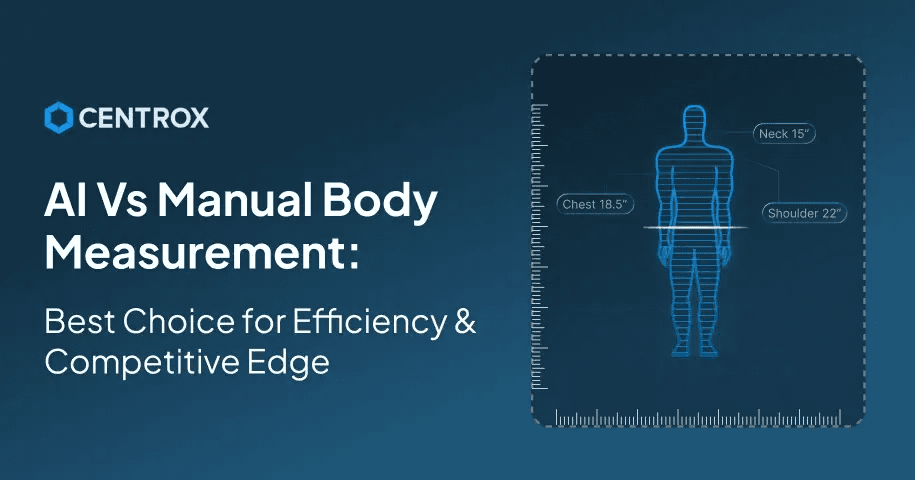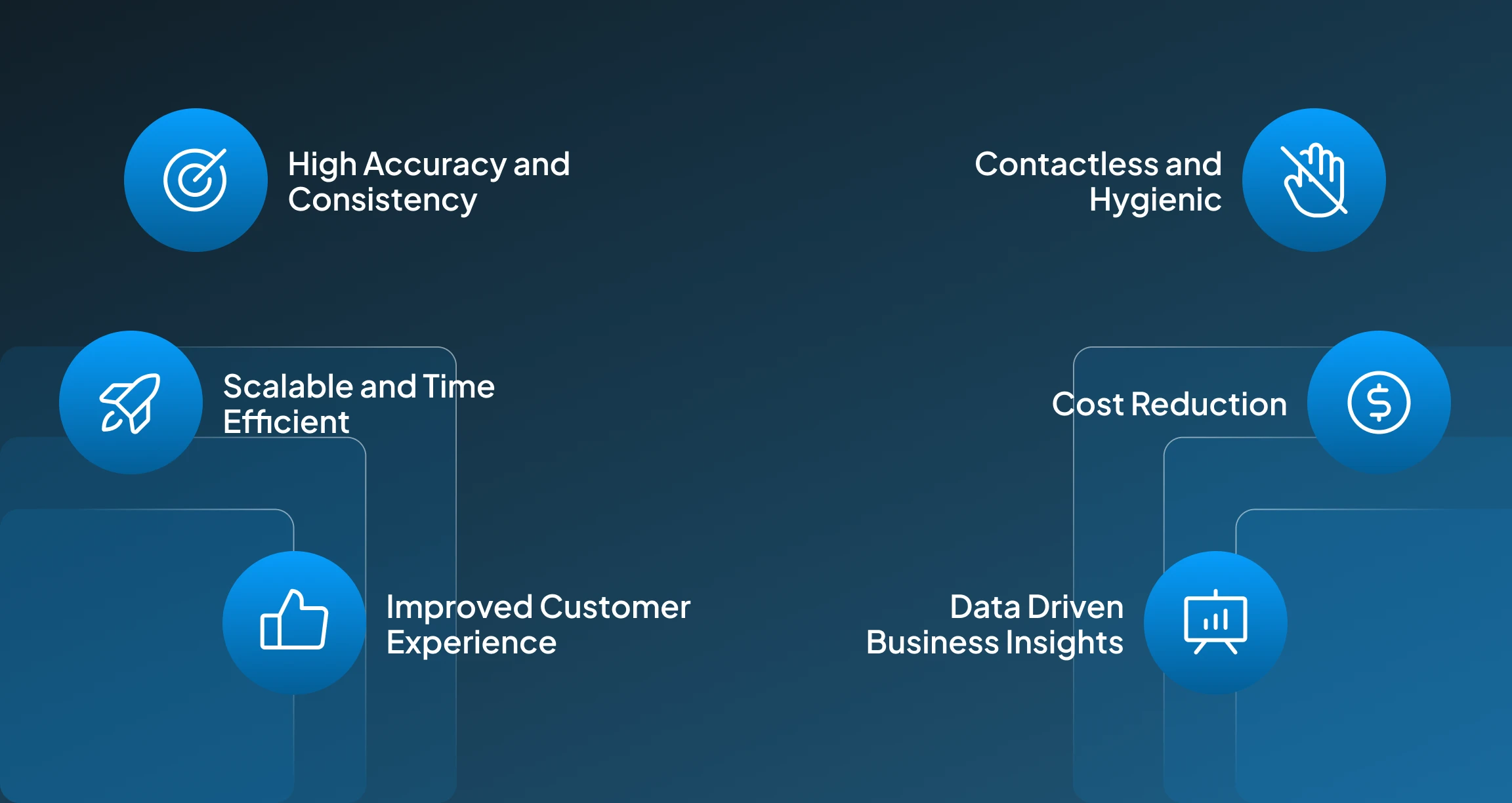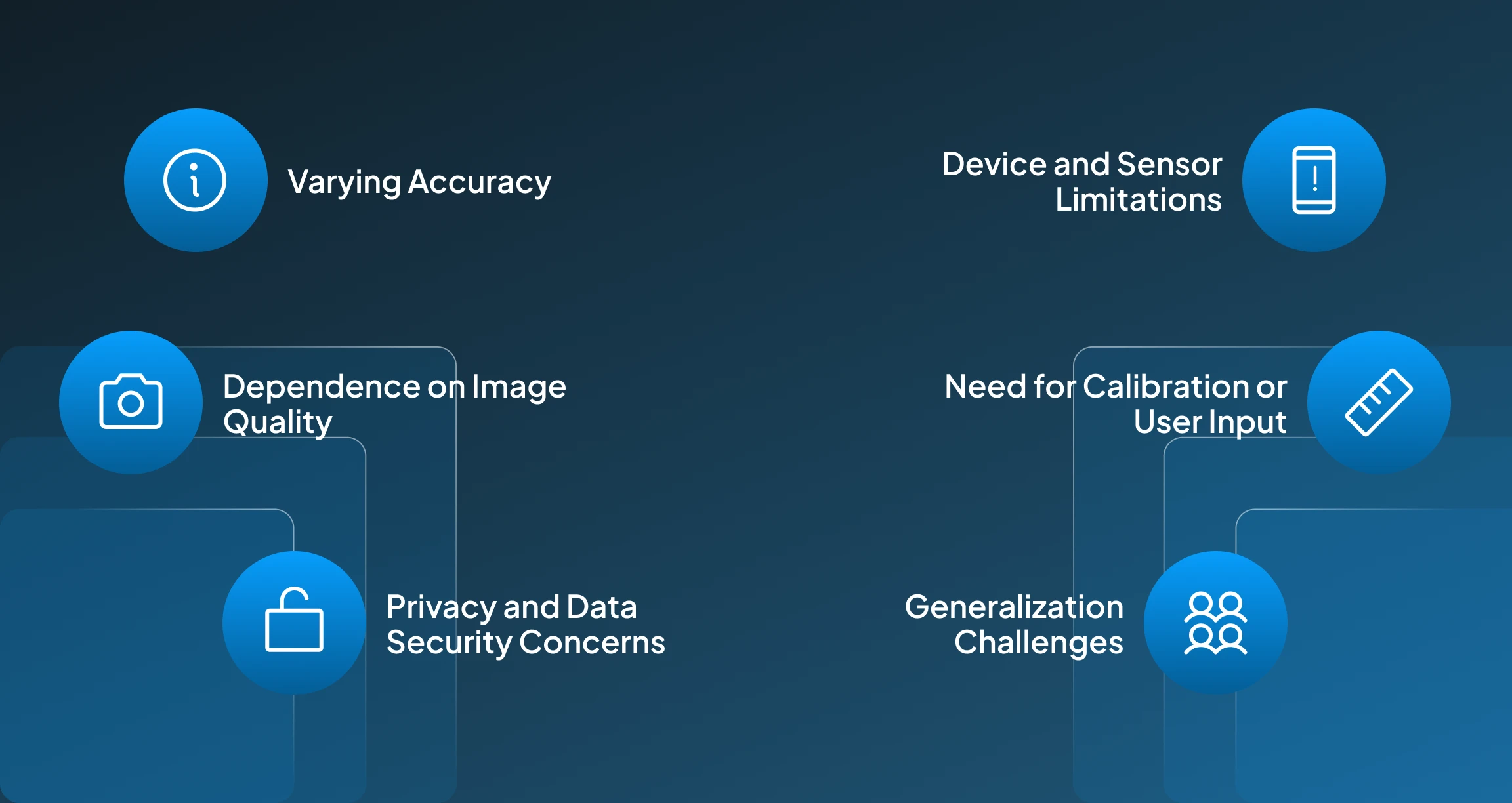AI vs Manual Body Measurement: Best Choice for Efficiency & Competitive Edge?
Compare AI vs manual body measurements to see which is more efficient and market-ready, with pros and cons of each.
7/21/2025
artificial intelligence
11 mins

We are living in an evolving era where innovations are completely transforming the overall workflows. Especially, the conventional manual body measurement operations for fashion, apparel, or retail businesses are not sufficient to cater to the growing demands. This eventually sparks the discussion around AI vs. manual body measurement practice.
The time and effort-consuming nature of traditional body measurement practices is affecting the operational efficiency of businesses. This created room for an AI-driven solution to bridge the gap between a business’s efficiency and growing market demand. Therefore, businesses today are in search of a solution that can help them in making the right balance between efficiency and competitive edge.
To help you solve this confusion, we are providing you with a comparative guide that sheds light on AI body measurement vs. manual body measurement. Through this article, you will learn how or why traditional measurement practices aren't enough, and which one should be your business's choice in order to develop autonomy and reputation in the market.
How Does AI Body Measurement Work?
AI body measurement allows an automated approach to performing body measurement tasks. This innovative approach uses Computer Vision algorithms to help in getting contactless, accurate measurements for different body types. Eventually, this makes the measurement process of the business smoother, faster, and more efficient.
Methodologies for AI Body Measurements
To decide on implementing AI-driven body measurement in your business, it is important to know the methodology that works on the back end of such a technology. Below, we have mentioned some methodologies that are used for AI-driven body measurements:
1. CV Based
The Computer Vision(CV) based AI body measurement solution works by using images or videos for identifying body landmarks and estimating the 3D body shape for calculating measurements of chest, weight, and height. It utilizes pose estimation, depth prediction, and machine learning to contribute accuracy, virtual fitting, and customized tailoring through contact-free measurements.
2. Deep Learning Model
A deep learning model can also be used for performing AI body measurements. It functions by analyzing the captured visual in image or video format through deep learning models like CNN or transformers. These models detect the main landmark of the body, estimate body pose and depth, and reconstruct a 3D model. These models learn the spatial relationships and body proportions from the diverse training dataset to make accurate measurements. Some models might also incorporate height or reference objects to improve scale and precision. (Mohamed et al., 2018)
3. Regression Model
Contrary to CV-based and deep learning model-based AI body measurements that completely depend on image analysis and 3D reconstruction, this regression model-driven AI body measurements solution uses extracted body features like pixel distances or ratios and maps them to actual measurements using a statistical relationship. This is a simple methodology that demands less computation and is often trained on a labeled dataset with known measurements. (Kristijan et al., 2022)
Benefits of AI Body Measurement Tools
AI-assisted body measurements can ensure some of the major benefits for retail, fashion, and apparel businesses, where accurate measurements are critical to get the perfect fit. Below, we have listed some major benefits that industries can experience through the integration of AI-driven body measurements:

1. High Accuracy and Consistency
AI-driven solution allows the provision of precise and repeatable body measurements, and significantly reduces the occurrence of inconsistent measurements caused by human error, ultimately enhancing especially in industries like fashion, fitness, and healthcare.
2. Scalable and Time-Efficient
By automating the process of body measurement, we can get more faster, precise, and efficient approach for calculating the measurement of body parts, making this AI solution ideal for e-commerce businesses, mass tailoring, and remote consultations.
3. Improved Customer Experience
With such an efficient AI solution for body measurement, we can enable customers to experience virtual try-ons and accurate size recommendations. This will enhance personalization and will contribute to minimizing the return rates caused by mismatched sizing.
4. Contactless and Hygienic
Such an AI-assisted solution for body measurements allows more comfortable and safer contactless body measurements. This makes this solution extremely impactful as it allows customers to measure remotely and get their customized outfits without visiting the store.
5. Cost Reduction
Reducing the need for physical fittings, manual labor, and in-person appointments helps businesses save on logistics and staffing, and eventually spend that money on increasing production numbers to drive more profit.
6. Data-Driven Business Insights
In today's time, data can play a key role in optimizing businesses' productivity and profitability. Tools of this nature can be used to collect anonymized sizing data to help brands analyze trends, improve inventory planning, and design better-fitting products for diverse body types and customer preferences.
Limitations of AI Body Measurement Tools
AI body measurement tool offers impactful benefits that can streamline and optimize the measurement process for fitness, clothing, apparel, or any other industry where body measurement is required. But as this AI-driven body meaurement is a fairly new concept, which is on its way to gaining maturity, it does hold some limitations in performance:

1. Varying Accuracy
These AI body measurement solutions may struggle to provide accurate body measurements for different body shapes, loose clothing, or non-standard posing, which can cause inaccurate measurements.
2. Dependence on Image Quality
Low lighting, cameras with compromised resolution, or pictures with a cluttered background can affect the AI body measurement model's performance in making accurate body measurements for your business application.
3. Privacy and Data Security Concerns
One of the major concerns around this AI-driven body measurement tool is about data protection, consent, and possible misuse of the collected data. As this collected image or video of the individual performing body measurements can be misused, ensuring safety for the data holds priority for safeguarding users' trust in the tool.
4. Device and Sensor Limitations
Although smartphones have become common these days, not all users have access to advanced mobile devices, which are LiDAR-enabled phones. This can contribute to limiting the consistency and accessibility of high-precision scanning.
5. Need for Calibration or User Input
Some AI body measurement systems require the user to provide height manually as user input or reference objects, which introduces potential user error and friction.
6. Generalization Challenges
As these AI Models are trained on limited datasets and they may deliver the best performance equally well across all ethnicities, age groups, or cultural clothing styles, because of their limited ability to generalize.
How does Manual Body Measurement Work?
Manual body measurement is the traditional approach for acquiring body measurements using physical tools. This job of body measurements is usually done by tailors, apparel or clothing business owners, or fitness trainers with the help of a measuring tape or ruler. However, for manual body measurements, the physical presence of the person for whom the measurement is required is necessary to take the measurements.
Methodology for Manual Body Measurement
The traditional way of acquiring body measurement involves the physical presence of the individual. This methodology for taking measurements is done through measurement tools like a tape or a ruler. This approach for body measurements is still very common, but it is highly inefficient.
Measurement through Tape or Ruler
The process of taking the measurements manually involves certain steps, which are mentioned below:
- Proper Posture
The required person has to stand upright, usually wearing tight-fitting clothing or minimal layers to ensure accurate and unobstructed measurements.
- Tape Placement
The measurer carefully wraps the measuring tape around specific body parts, such as the chest, waist, hips, arms, or legs.
- Reading the Measurement
The measurement is read from the tape where the end meets the rest of the tape, typically noted in inches or centimeters.
- Verification
Measurements may be repeated to ensure consistency and reduce the chances of human error.
Benefits of Manual Body Measurement
The manual approach toward body measurements is still common and popular among fashion, apparel, and fitness businesses. Despite being slow, businesses still use this approach because of its reliability and the personalized touch it tends to offer. To provide you with a better overview, we have listed down some key benefits of the manual body measurement approach:
1. High Precision
With a manual approach to body measurement, we can have more precise measurements since the tailor, healthcare professional, or fitness trainer holds expertise and experience in handling the assigned job.
2. No Technology Required
This manual approach to body measurement doesn't have a dependency on any technology-driven tools. Making it accessible, affordable, and usable anywhere around the world without dependence on power or device availability.
3. Real-Time Adjustment
An incorrect posture or symmetry affecting the measurements can instantly be highlighted by the expert. At the same time, it can be adjusted accordingly to make an outfit that fits perfectly for the target customer.
4. Personalized Human Touch
The presence of a human measurer allows for dialogue, clarification, and trust, especially important in bespoke tailoring or medical assessments.
5. Available offline and in low-tech environments
This manual body measurement tool is especially ideal for areas where internet infrastructure is unavailable or rarely available. It helps professionals to make body measurements for tailoring or fitness purposes without overly depending on the tool itself.
Limitations of Manual Body Measurement
Despite being an extremely popular practice for body measurements, this manual body measurement methodology has its share of challenges. For your help, we have listed some limitations faced during manual body measurement:
1. Prone to Human Error
The manual approach for body measurements depends mainly on the expertise of professionals taking the body measurements. Therefore an error in taking the measurements can result in inaccurate fitting of clothes.
2. Time-Consuming
The manual methodology for body measurements requires the professional to separately measure each required part. This makes the measurement process time-consuming and slow.
3. Requires Expertise
Accurate results depend heavily on the skill and experience of the person measuring, which limits scalability and standardization, making manual body measurement highly dependent on human skills.
4. Lack of Record Keeping
For manual measurements, the measurement record is often noted on paper in a notebook, from which searching for information is difficult and time-consuming. AI-driven tools can efficiently save records in their databases for user convenience. This measurement data can be reused from there as per the user's instructions.
5. Privacy Concerns
Manual measurements require contact, which can make the users uncomfortable, disrupting the user experience. In such a scenario a contactless measurement approach can significantly help in saving the user from this inconvenience.
AI vs Manual Body Measurement: Which one is best?
Choosing between an AI and a Manual approach for body measurements is definitely confusing for businesses. To help you find the ideal approach, we have shortlisted some key factors that you should consider while selecting an approach for your fashion or fitness measurement process:
| Factors | AI Body Measurement | Manual Body Measurement |
|---|---|---|
| Accuracy | High (with well-trained models) | Varies (depends on the measurer's skill) |
| Speed | Very fast (seconds to minutes) | Slower; takes time per person |
| Consistency | Highly consistent across sessions | Inconsistent; prone to human error |
| Scalability | Easily scalable across users/devices | Not scalable; limited by human time/effort |
| Comfort and Privacy | Contactless, remote-friendly | Requires physical contact; can feel intrusive |
| Technology Needs | Requires devices, software, and sometimes sensors | Needs only basic tools (e.g., tape measure) |
AI Vs Manual Body Measurement
Although both AI and Manual Body Measurement have their own pros and cons. However, the AI-driven approach can bring a positive impact in enhancing the efficiency and productivity of businesses, ultimately making them more profitable. However, the Manual methods remain suitable for low-tech, small-scale businesses that can't afford to invest in such a high-tech solution in the early phase.
Thoughts to Consider
Choosing between implementing AI or a manual measurement approach for your business process can get confusing. But if you want to grow your business at scale, then the AI-driven body measurement tool can deliver fast, accurate, and consistent performance for your business's body measurement needs.
This AI-driven automated approach for body measurements allows you to focus more on strategizing higher-level approaches for uplifting business sales, production, and profit. As it can reliably take this responsibility of taking measurements off your shoulder. It has the potential to work as your smart assistant for fashion, apparel, and retail business that not only performs accurate measurements but also keeps a record of them to provide personalized recommendations.
So in the future, we can anticipate a fast-paced world where customers would prefer quick, easy, quality, trustworthy service. Here, integrating AI tools positions your business for long-term success and a competitive edge in an evolving market.
Is sizing inconsistency one of the reasons for the high product return rate in your business? Book your session with our AI experts at Centrox AI, and find out how the AI body measurements solution can solve this problem for you, alongside bringing other benefits.

Muhammad Haris Bin Naeem
Muhammad Harris Bin Naeem, CEO and Co-Founder of Centrox AI, is a visionary in AI and ML. With over 30+ scalable solutions he combines technical expertise and user-centric design to deliver impactful, innovative AI-driven advancements.
Do you have an AI idea? Let's Discover the Possibilities Together. From Idea to Innovation; Bring Your AI solution to Life with Us!
Your AI Dream, Our Mission
Partner with Us to Bridge the Gap Between Innovation and Reality.
